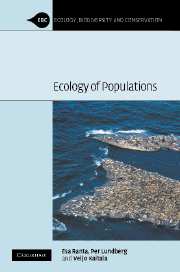Book contents
- Frontmatter
- Contents
- Preface
- 1 Introduction
- 2 Population renewal
- 3 Population dynamics in space – the first step
- 4 Synchronicity
- 5 Order–disorder in space and time
- 6 Structured populations
- 7 Biodiversity and community structure
- 8 Habitat loss
- 9 Population harvesting and management
- 10 Resource matching
- 11 Spatial games
- 12 Evolutionary population dynamics
- 13 Epilogue
- References
- Index
8 - Habitat loss
Published online by Cambridge University Press: 02 December 2009
- Frontmatter
- Contents
- Preface
- 1 Introduction
- 2 Population renewal
- 3 Population dynamics in space – the first step
- 4 Synchronicity
- 5 Order–disorder in space and time
- 6 Structured populations
- 7 Biodiversity and community structure
- 8 Habitat loss
- 9 Population harvesting and management
- 10 Resource matching
- 11 Spatial games
- 12 Evolutionary population dynamics
- 13 Epilogue
- References
- Index
Summary
Our focus is on population fluctuations, extinction risks, and on species coexistence in a fragmented landscape. As this is an entirely theoretical enterprise, we can control for various aspects (constant carrying capacity, fixed density of fragments per unit area, increasing isolation, etc.) while altering others. This is often impossible to achieve with natural systems. The concept of refugee-arrival (former inhabitants of habitats lost) caused perturbations in local populations will be introduced. In addition, we shall explore population fluctuations in the center and border of a species' distribution range. Finally, we shall provide a few explanations as to why species with periodic multi-annual dynamics may lose the cycle.
What is meant by habitat loss?
The issue of habitat loss brings into mind various aspects of changes over time in pristine habitats in nature. Often we tend to associate habitat loss with human-caused consequences: intensifying agriculture initially, timber logging for sawmills and pulp mills of the paper industry, not forgetting urban development (fig. 8.1). The picture that we tend to have in mind when somebody mentions “habitat loss” is that in the beginning there was large widespread homogeneous coverage of uniform habitat areas all over a given biome. Ever since those times everything has deteriorated, fragmented, and we have lost habitats. Areas suitable for breeding of a given species have become isolated from each other. Many species have become extinct and numerous others have become threatened. This has all happened in a very short historical time.
- Type
- Chapter
- Information
- Ecology of Populations , pp. 181 - 212Publisher: Cambridge University PressPrint publication year: 2005



